Ground-based Observations - BepiColombo Flyby
Observability from Ground
On the early morning of the 10th of April, there will be the possibility to observe the crossing on the sky of BepiColombo spacecraft (given that the sky will be clear, of course!). The closest approach is foreseen at 04.25 UTC with a minimum distance of 12.677 km from the Earth’s surface.
Observers at latitudes close to the equator, especially in the southern hemisphere, will be favoured in terms of elevation on the horizon and apparent magnitude. Unfortunately, the presence of the Moon, being two days after the full moon phase, will brighten part of the sky, and the time of the BepiColombo closest approach to the Sunrise will make this observation more difficult. However, amateur astronomers, astronomy-addicted people, astro-photographer and curious people are invited to accept this challenge, trying to catch the passage of BepiColombo with their telescopes, binoculars and cameras.
In addition to the BepiColombo event, on the morning of April 10th there will be a triple large conjunction in the sky area crossed by the spacecraft. Over the local horizon (with differences depending on the location of the observer) a very nice configuration will be observed with Jupiter, Saturn and Mars aligned at different heights and relatively close to each other; an angular separation of about 5° 45’ between Jupiter and Saturn, about 6° between Saturn and Mars. Their magnitudes will be relatively high, allowing to see them by naked-eye, not only under dark skies but also from the cities. Jupiter will be the brighter with an apparent magnitude of -2.2, whereas Saturn and Mars will shine at around +0.6.
The possibility of making a large field image with a triplet of very famous planets, Jupiter, Saturn and Mars, and the crossing of BepiColombo is a great opportunity that can not be missed. The estimated apparent magnitude (m = 8, in the best conditions) is not enough to see it by naked -eye. However, with the right instrument and with the proper in-time preparation it will be possible to take pictures of the event or simply to observe it.
In the following figure the variation of the estimated apparent magnitude of the BepiColombo spacecraft is plotted on the different regions of the Earth, with a minimum value (i.e. highest visibility) reached in the red-coloured regions. Latitudes around the equator and the southern hemisphere will be favoured.
Variation of the apparent magnitude of BepiColombo spacecraft for different areas of the Earth. As shown by the legend, red-couloured areas are favoured for the observation since the apparent magnitude reaches a maximum value of +8.
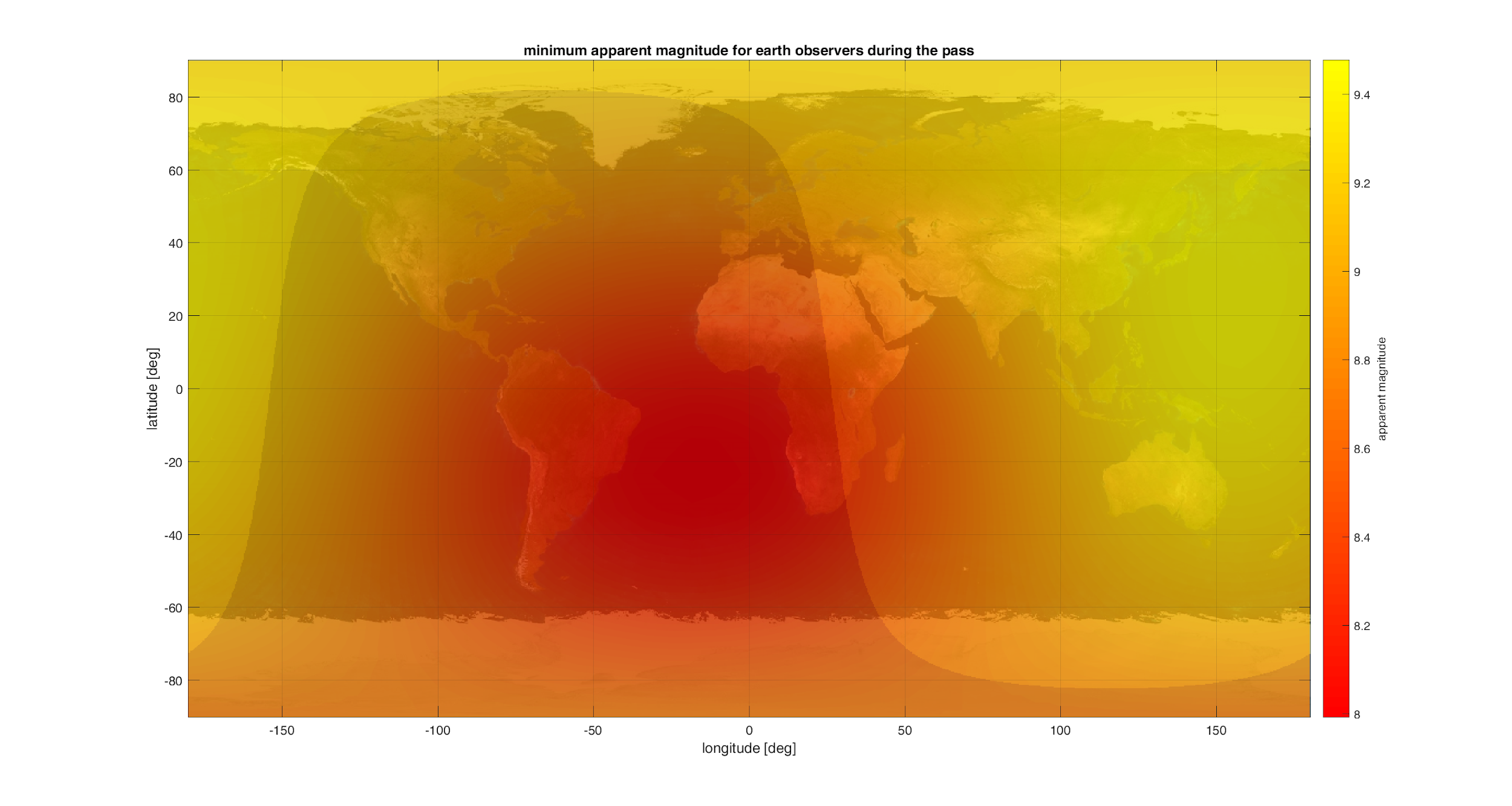
Variation of the apparent magnitude of BepiColombo spacecraft for different areas of the Earth. As shown by the legend, red-couloured areas are favoured for the observation since the apparent magnitude reaches a maximum value of 8
Observability in specific Places
In the following images details on the observability conditions from some locations are reported and analysed. In particular, Rome (Italy), Cebreros (Spain), Cape Town (South-Africa) and La Palma island in the Canaries (Spain) have been chosen.
The following table reports the main details of the BepiColombo flyby as seen from different observers on the Earth.
| Site | Rise (UTC) | Set (UTC) | Max elevation (degrees) | Azimuth (degrees) | Time @ max elevation (UTC) | Minimum distance (km) |
|---|---|---|---|---|---|---|
| Rome (Italy) | 02:54:31 | 04:35:08 | 15.29 | 154.69 | 03:58:24 | 17.002 |
| Cebreros (Spain) | 03:33:28 | 04:50:23 | 11.88 | 165.63 | 04:15:55 | 16.761 |
| La Palma (Canary islands/Spain) | 03:46:53 | 05:20:53 | 23.20 | 177.96 | 04:30:43 | 15.642 |
| Cape Town (Soutd-Africa) | 02:45:18 | 05:03:17 | 64.45 | 349.58 | 04:11:46 | 13.405 |
Data of the event have been computed by using the SPICE Kernels of the BepiColombo mission (BepiColombo Dataset v221 -- Planning 20200311_001, https://www.cosmos.esa.int/web/spice).
If you want to compute your own plot for your location by inserting latitude and longitude here: https://bepicolombo.iaps.inaf.it.
Rome - Italy
This is the observation from Rome, Italy, towards the area where the BepiColombo spacecraft will cross the sky 1 hour before the Earth closest approach (05:25in local time, i.e. UTC +2): at this time, the sky will be still dark, and visibility should be good. Sun rise will start at about 06:30 (UTC).
In Rome the spacecraft will rise above the horizon towards East at 04:54:31 local time (UTC +2), it will increase its altitude progressively to a maximum of 15.3 degrees towards South-East/South (azimuth = 154. 7 degrees) at 05:58:24 and then will decrease the elevation and go below the horizon at 06:35:08 local time. This will be also about the time of Sunrise.
Night sky over Rome, Italy, with viewing direction to the area where the BepiColombo spacecraft will transit during the fly-by. The red line is the ecliptic. The view time is fixed at 2020/4/10 5:25:00, local time (UTC + 2), one hour before the Earth closest approach. At this latitude BepiColombo will reach a maximum elevation on the local horizon of almost 15 degrees at 05:58:24 and a minimum distance from Rome of 17002 km at 06:18:25. Local times are used: UTC +2 (credits: Stellarium https://stellarium.org/)
At the maximum altitude BepiColombo will be about 7 degrees under Jupiter. The minimum distance from Rome, about 17002 km, will be reached at 06:18:25 local time. Overall, the sky crossing over the horizon will last about 1 hour and 40 minutes. The figure below shows the trajectory of BepiColombo in the sky and the corresponding times. An estimate of the apparent magnitude during the pass is reported as well.
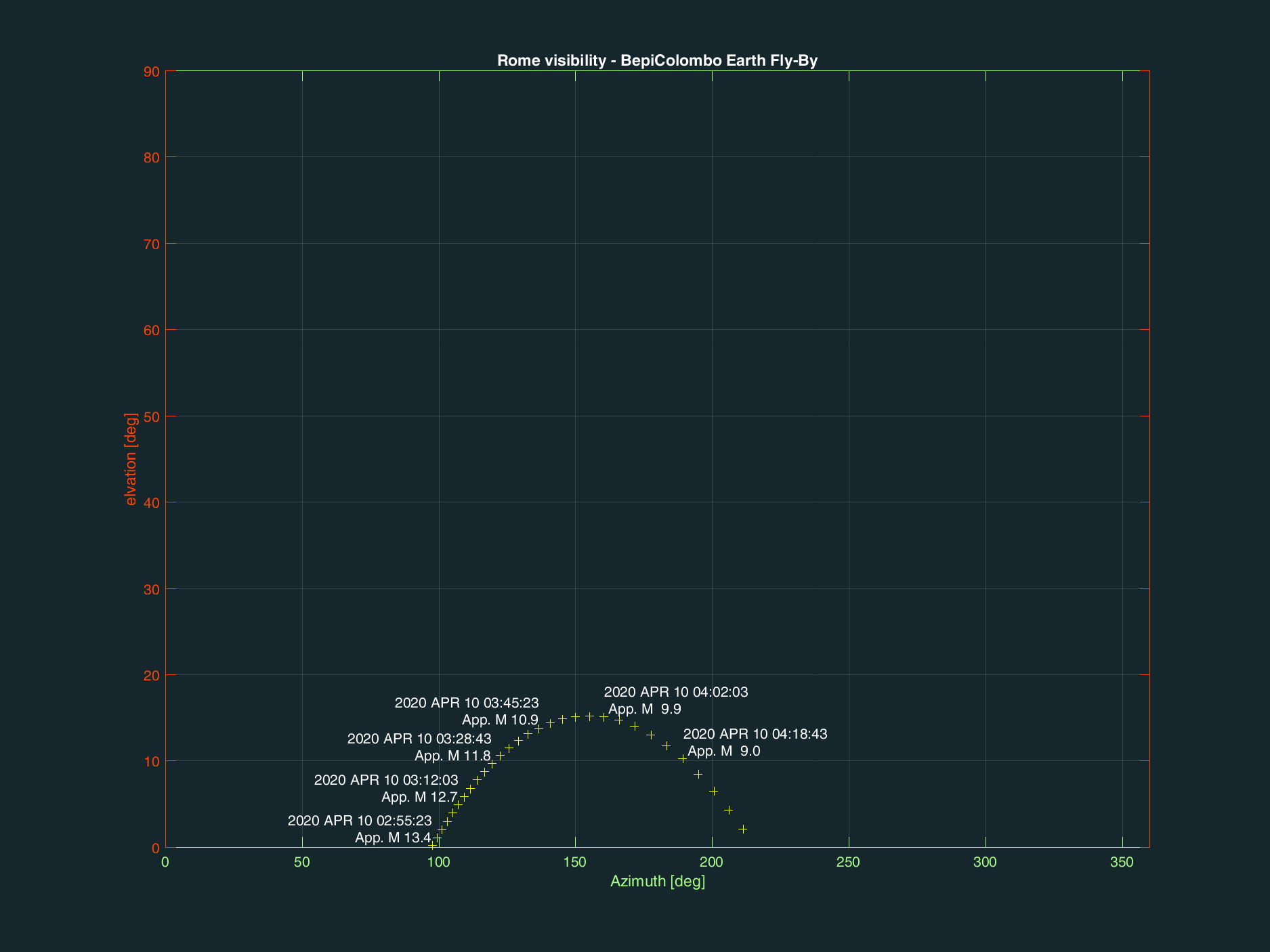
BepiColombo trajectory in the sky of Rome, Italy. Times in UTC are reported, along with an estimate of the apparent magnitude during the pass.
Capetown - South Africa
The following figure shows the sky view for an observer from Cape Town, South-Africa, towards the area where the BepiColombo spacecraft will cross the sky. The time chosen is at the Earth closest approach (06:25, local time, i.e. UTC +2). For this latitude, the elevation on the horizon will be very high, allowing to observe better the passage in the sky. The figure below shows the sky view from Cap Town during the passage. The red line is the ecliptic.

Night sky over Cape Town, South-Africa, with viewing direction to the area where the Bepi Colombo spacecraft will transit during the fly-by. The red line is the ecliptic. The time si fixed at 2020/4/10 06:25:00, local time (UTC + 2), time of the Earth closest approach. At this latitude BepiColombo will reach a maximum elevation on the local horizon of almost 65 degrees and a minimum distance from Cape Town of 13405 km at 06:18:57. Local times are used: UTC +2 (credits: Stellarium https://stellarium.org/)
The spacecraft will rise on the horizon towards East at 04:45:18 local time (UTC +2), it will increase fastly its altitude till to a maximum of 64.5 degrees towards Nord (azimuth = 349. 6 degrees) at 06:11:46 and then will decrease the elevation fastly till to go under the horizon at 07:03:17 close to West. The minimum distance from Cape Town, about 13405 km, will be reached at 06:18:57 local time. Overall, the sky crossing over the horizon will last about 2 hours and 20 minutes. The figure below shows the trajectory of BepiColombo in the Cape Town sky and the corresponding times in UTC (local times are UTC +2). An estimate of the apparent magnitude during the pass is reported as well.
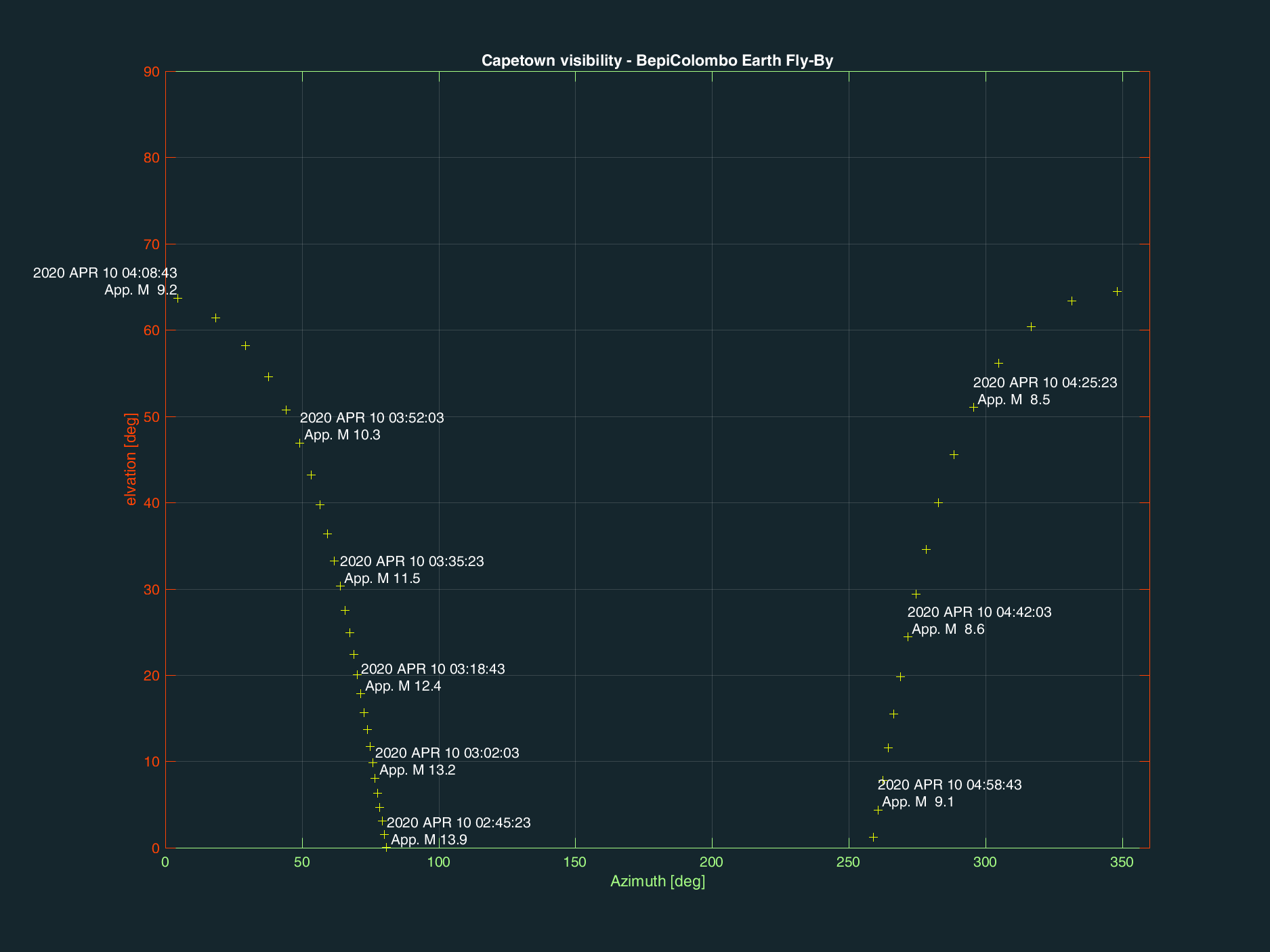
BepiColombo trajectory in the sky of Cape Town, South Africa. Times in UTC are reported, along with an estimate of the apparent magnitude during the pass.
Roque de los Muchachos - La Palma, in Canary islands
The following figure shows the sky view for an observer from Roque de los Muchachos (2396 m), at La Palma, in Canary islands (Spain), towards the area where the BepiColombo spacecraft will cross the sky. The time chosen is at the Earth closest approach (05:25, local time, i.e. UTC +1). From this site the elevation of the trajectory will be beeter with respect to an observer from Roma, for instance. The figure below shows the sky view from Roque del Los Muchachos during the passage. The red line is the ecliptic.
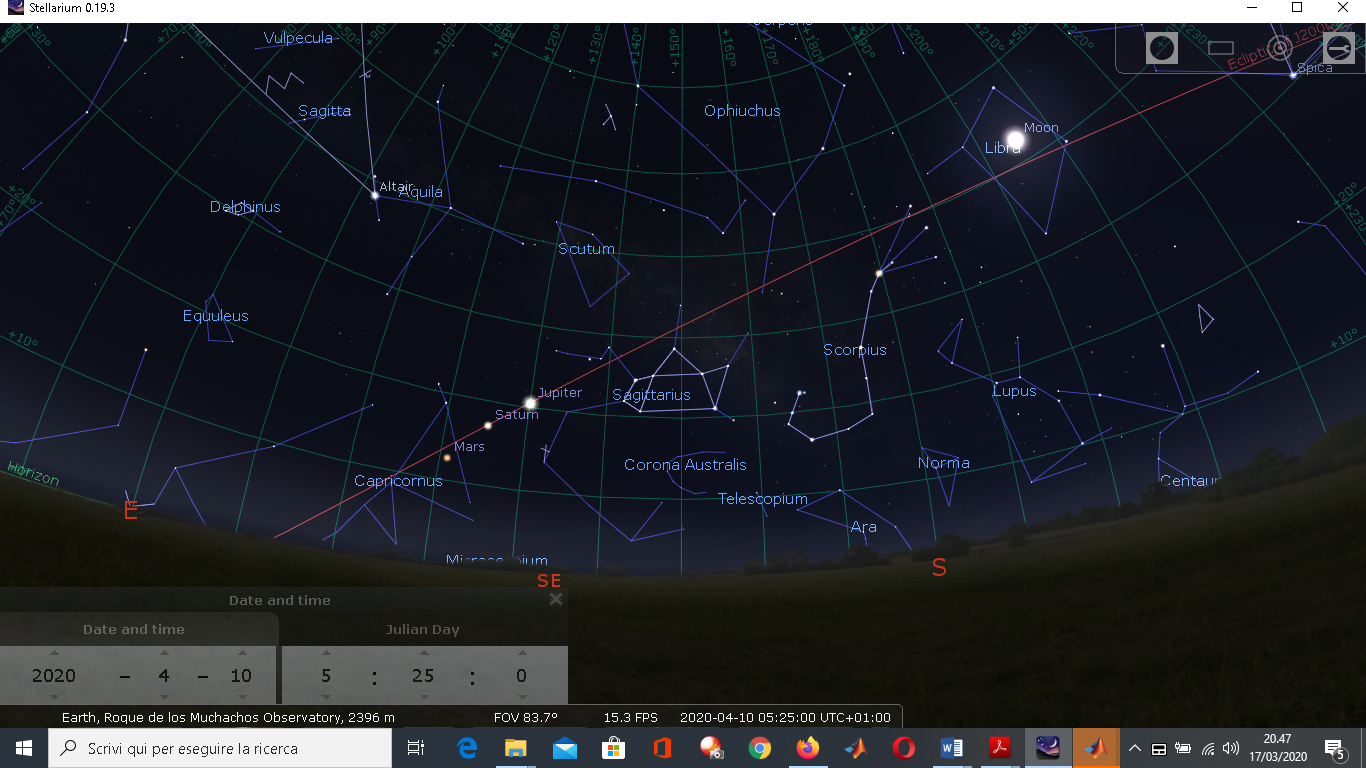
Night sky over Canary Islands (La Palma, Spain), at Roque de Los Muchachos Observatory, with viewing direction to the area where the Bepi Colombo spacecraft will transit during the fly-by. The time si fixed at 2020/4/10 05:25:00, local time (UTC + 1), time of the Earth closest approach. At this latitude BepiColombo will reach a maximum elevation on the local horizon of almost 23 degrees and a minimum distance from Roque de Los Muchachos of 15642 km. Local times are used: UTC +2 (credits: Stellarium / https://stellarium.org/).
The spacecraft will rise on the horizon close to East at 04:46:53 local time (UTC +1), it will increase progressively its altitude till to a maximum of 23.2 degrees towards South (azimuth = 178 degrees) at 05:30:43 and then will decrease the elevation till to go under the horizon at 06:20:53 close to West/South-West. The minimum distance from Roque de Los Muchachos, about 15642 km, will be reached at 05:27:12 local time. Overall, the sky crossing over the horizon will last about 1 hour and 40 minutes. The figure below shows the trajectory of BepiColombo in the Canary Islands sky and the corresponding times in UTC (local times are UTC +1). An estimate of the apparent magnitude during the pass is reported as well.
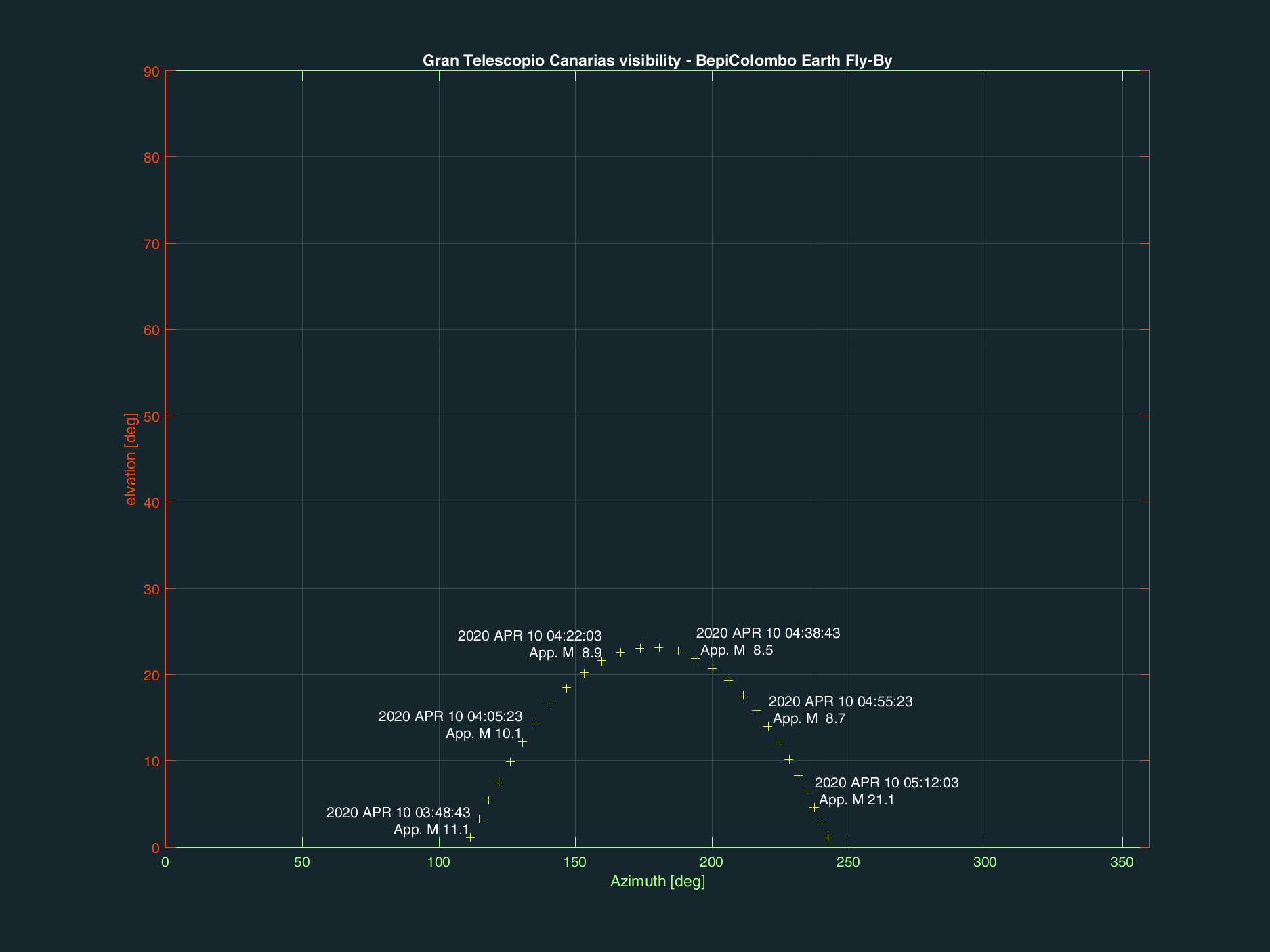
BepiColombo trajectory in the sky of Roque los Muchachos, at La Palma, in the Canary islands. Times in UTC are reported, along with an estimate of the apparent magnitude during the pass.








































 Sign in
Sign in
 Science & Technology
Science & Technology